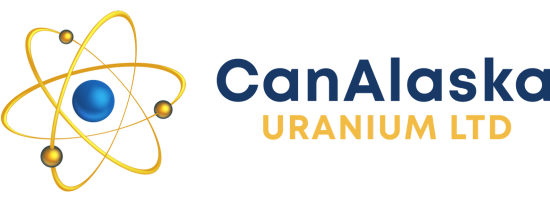Vancouver, Canada, September 16th, 2009 – CanAlaska Uranium Ltd. (TSX.V — CVV) (“CanAlaska” or the “Company”) has carried out a summer program of surface trench sampling and mapping on the western portion of the Fond Du Lac project, as well as a separate drill program on the Fond du Lac mineral deposit. Both areas contain significant surface, and near surface, uranium mineralization. For the western target area, the Company is pleased to report high grades of uranium mineralization obtained from the first saw-cut representative channel samples from the Adair Showing. This mineralized zone is located north of the Company’s Helmer Project and within the western portion of its Fond Du Lac Project, which is situated on the reserve lands of the Fond Du Lac Denesuline First Nation, (see Fig 1).

The main showing consists of two historical trenches within a gossanous area on the southeast side of a 3 km swampy topographic low. This linear trend coincides with a magnetic low on the south side of a sharp linear magnetic feature. Historical drilling (1953) consisted of 14 holes spread over a length of 2.8 km of this zone. The eight southern holes covering 1.2km of this zone intercepted uranium mineralization underneath the zone and its projected extensions. The northern four holes are not reported to have significant mineralization, however recent samples from surface outcrops show a continuation of the zone in this area, (see Fig 2). There has been no modern exploration in this area since the 1960’s, when the area was deemed a First Nation reserve. CanAlaska sampling programs in 2008 identified significant mineralization in the area, with values over 5% U3O8 from grab samples. In summer 2009, the area was revisited and systematic representative sampling was carried out.

Off-scale scintillometer readings across a narrow (5-10cm wide) mineralized zone define the target for over 35 metres in an area where old trenches and stripping have exposed bedrock near the centre of the zone (see Fig 3). Further exposures are intermittent along the structure, which has been confirmed by drilling. Along with mapping and prospecting, CanAlaska geologists collected a set of six representative saw-cut channel samples, each of 50 cm length, across the fracture fill mineralization. The average uranium content of these samples is 0.94% U3O8 (18.8 lb/ton U3O). Two of the samples also reported gold grades of 0.7g/t Au, and two samples contained anomalous platinum mineralization. Sample values are reported in Table 1.
Table 1. – Representative Channel Samples from 35 metres of Adair Showing, Fond Du Lac Project
| Sample | Grid X | Grid Y | Sample Location | Width cm | U3O8 % | U3O8 lb/ton | Au g/t | Pt ppb | Pd ppb |
| GS069 | 503 | 094 | 35 | 50 | 1.42 | 28.4 | 0.771 | 2 | 2 |
| GS072 | 506 | 092 | 31 | 50 | 0.25 | 5 | 0.59 | 2 | 3 |
| GS071 | 516 | 088 | 21 | 50 | 0.1 | 2 | 0.719 | 323 | 397 |
| GS070 | 518 | 086 | 18 | 50 | 1.77 | 35.4 | 0.027 | 26 | 29 |
| GS068 | 530 | 078 | 4 | 50 | 0.63 | 12.6 | 0.018 | 2 | 14 |
| GS067 | 532 | 6075 | 0 | 50 | 1.49 | 29.8 | 0.075 | 2 | 2 |
Prior Drill Holes and Down-hole Radiation Measurements
Historical drilling consisted of 14 drill holes with an average depth of 185 feet (56 metres), along 2.8 km of the zone. A review of (limited) historical records indicated that at least 5 drill holes (DDH’s # 5, 7, 9, 10, and 13) were significantly mineralized with uranium, based on down-hole probe information.

DDH#11 is lacking probe information, but is reported to intersect garnet biotite gneiss, with some mafic layers and frequently pyritic. This drill hole (#11) was not probed because the hole collapsed near surface at a 10 foot wide (3 metre) highly sheared and brecciated zone. DDH #11 is 204 feet (62 metres) deep and contains four zones of sheared, brecciated, and hematised chloritic schist, some of which is graphitic. The core logging for this drill hole is very similar to that of the mineralised sections in the other drill holes, but it contains a larger number of schist sections.
No chemical assays are available from the samples from the historical core, and similarly, the archived drill logs do not contain radioactivity measurements of the core. However, the historical records do show that the drill holes were measured by doing point by point measurements with a probe, up and down the holes, presumably using a Geiger Muller detector. The radioactivity is expressed in counts per minute, rather than the current higher counts per second of a modern scintillometer.
CanAlaska’s evaluation of this data is that the probing defines a consistent mineralized zone. The reported probe measurements from the zones intercepted down-hole, indicate values of up to 120 times the normal background radiation. The following table represents these data, but a direct comparison to current scintillometer readings is not applicable, because of the non-linear correlation and factoring required to perform the computation. The best current comparison is with the assay grades reported here in Table 2, from surface exposures within the middle of the zone.
Table 2. Adair Zone: Geiger Measurements of Down-hole Radioactivity
| Drill hole | From (ft) | To (ft) | Width of mineralization (ft) | Peak radiation vs background |
| DDH #6 | 121 | 123 | 2 | 9 times |
| DDH #7 | 38 | 40 | 2 | 70 times |
| DDH #7 | 44 | 45 | 1 | 120 times |
| DDH #9 | 175.5 | 176 | 0.5 | 25 times |
| DDH #9 | 209 | 211 | 2 | 25 times |
| DDH #10 | 45.5 | 46.6 | 1 | 25 times |
| DDH #13 | 120 | 122 | 2 | 20 times |
| DDH #13 | 169.5 | 172 | 2.5 | 35 times |
The grade and consistency of the mineralized structure provides a significant target for future exploration efforts. The topographic low along which the mineralization occurs coincides with a magnetic low as measured by the recent airborne surveys. This magnetic low is interpreted as a large shear zone which cuts the basement stratigraphy at a low angle. The Company is now evaluating early winter drilling along the zone.
CanAlaska is fully-funded for current operations and is budgeting for extensive fall-winter 2010 exploration programs, financed by its strategic joint venture partnerships and from current treasury. The Company is presently awaiting assay results from drill samples from summer exploration that was undertaken in a separate region of the Fond Du Lac Project, and from extensive mapping and sampling work at the Poplar Project, where the company has been working for the past month with six Chinese-trained geologists from East Resources Inc. The drill and assay results from these active projects will be provided as they become available to the Company.
All of the prospecting and drill samples from the Fond Du Lac Project were submitted to Acme Laboratories Vancouver, an ISO 9001:2000 accredited and qualified Canadian Laboratory to be analysed for uranium and multi-element geochemistry by tri-acid digestion and ICP-MS., or to the Saskatchewan Research Council Geoanalytical Laboratory for a Multi Element ICP analysis with Aqua Regia digestion The samples were collected by CanAlaska field geologists under the supervision of Dr. Karl Schimann, and were shipped in secure containment to the laboratories noted above. Peter Dasler, M.Sc., P Geo. is the qualified technical person responsible for this news release.
About CanAlaska Uranium Ltd. — www.canalaska.com
CANALASKA URANIUM LTD. (CVV — TSX.V, CVVUF — OTCBB, DH7 — Frankfurt) is undertaking uranium exploration in twenty 100%-owned and three optioned uranium projects in Canada’s Athabasca Basin — the “Saudi Arabia of Uranium”. Since September 2004, the Company has aggressively acquired one of the largest land positions in the region, comprising over 2,500,000 acres (10,117 sq. km or 3,906 sq. miles). To-date, CanAlaska has expended over Cdn$55 million exploring its properties and has delineated multiple uranium targets.
CanAlaska’s geological expertise and high exploration profile has attracted the attention of major international strategic partners. Among others, Japanese conglomerate Mitsubishi Corporation has undertaken to provide the Company C$11 mil. in exploration funding for its West McArthur Project. Exploration of CanAlaska’s Cree East Project is also progressing under a C$19 mil. joint venture with a consortium of Korean companies led by Hanwha Corporation, and comprising Korea Electric Power Corp., Korea Resources Corp. and SK Energy Co, Ltd. Exploration recently commenced on the Poplar Project with Chinese mining partner East Resources Inc., comprising a potential 100,000 metres of drill testing. In addition, Canadian explorer Kodiak Exploration has also optioned the McTavish Project to advance exploration with the goal of attaining a 60% project interest earn-in by delineating a minimum of 35 million pounds U3O8.
On behalf of the Board of Directors
“Peter Dasler”
Peter Dasler, P. Geo., President & CEO
Investor Contact: Emil Fung, Vice President, Corporate Development
Tel: +1.604.688.3211 Toll Free (North America) 1-800-667-1870 Email: info@canalaska.com
The TSX Venture has not reviewed and does not accept responsibility for the adequacy or accuracy of this release: CUSIP#13708P 10 2.
This news release contains certain “Forward-Looking Statements” within the meaning of Section 21E of the United States Securities Exchange Act of 1934, as amended. All statements, other than statements of historical fact, included herein are forward-looking statements that involve various risks and uncertainties. There can be no assurance that such statements will prove to be accurate, and actual results and future events could differ materially from those anticipated in such statements. Important factors that could cause actual results to differ materially from the Company’s expectations are disclosed in the Company’s documents filed from time to time with the British Columbia Securities Commission and the United States Securities & Exchange Commission. Not to be construed as an offer to buy or sell securities of CanAlaska Uranium Ltd.

